With a striking rapid-paced cross-cutting cold open that catches you by surprise when protagonist, Manhattan District Attorney Lauren Monroe, is blindsided by the press who confront her about the death of her prominent politico father’s death, a death of which she was not even aware, you are hooked. A cat and mouse thriller directed by VAUGHN STEIN with script by Matthew Kennedy making his feature screenwriting debut, INHERITANCE is a cat and mouse thriller that relies as much on its metaphoric visual labyrinth as it does Kennedy’s twists and turns within the story itself.
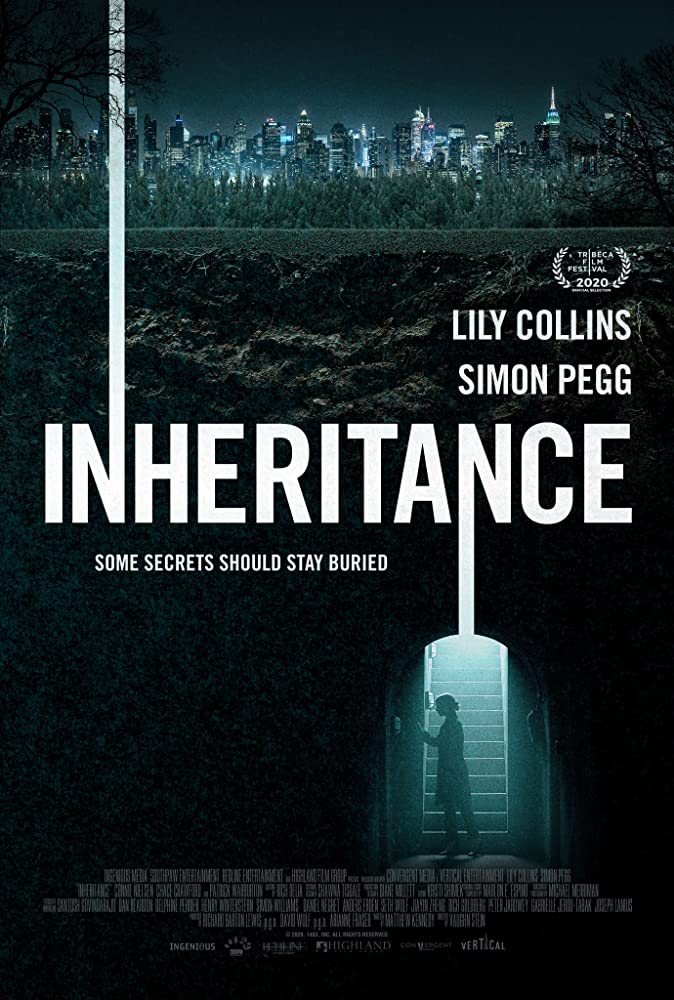
With the death of Lauren’s father and the reading of his Will, not only is a shocking secret revealed to Lauren, but that secret is only revealed as she begrudgingly endeavors to fulfill her late father’s wishes and locate a mysterious inheritance, an inheritance she is to disclose to no one. Adding to the uncomfortableness of this inheritance is that Lauren’s brother William is running for congressional reelection. Between the campaign and the elder Monroe’s death, and their mother’s insistence that Lauren be front and center participating in William’s campaign, the family is placed under an even brighter spotlight and more scrutinous lens. Can Lauren fulfill her obligations and honor her father or will the secret tear the family apart if it comes to light?
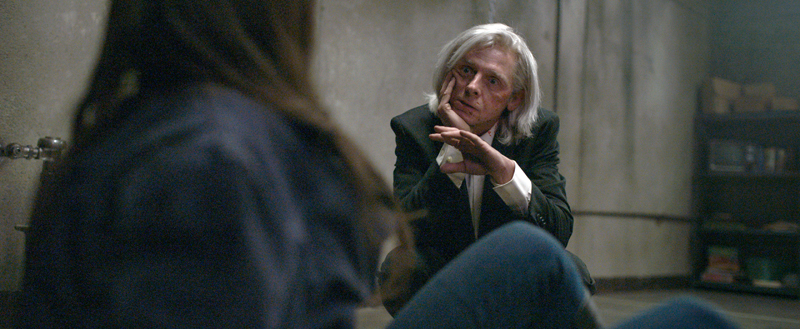
Glossy and gritty rich cinematography from Michael Merriman and intricate production design by Diane Millett are showcased with rapier edge-of-your-seat editing by Kristi Shimek, often utilizing stylized rapid cross-cutting, keeps the intrigue and suspense of INHERITANCE high. While Lily Collins as the stoic and somewhat cold Lauren delivers a strong performance on her own, she is at her best when going toe-to-toe against an award-worthy Simon Pegg. Pegg is mesmerizing, disappearing into an emotionally complex, manipulative, and disturbing character. Virtually unrecognizable in his physical transformation, Pegg will blow your mind. With a supporting cast that boasts the talents of Connie Nielsen as Lauren’s mother Catherine Monroe, Chace Crawford as brother William, Patrick Warburton as patriarch Archer Monroe, and Michael Beach as family attorney Harold Thewlis, there is plenty of intrigue to go around, although the focus of INHERITANCE is on Collins’ Lauren and Pegg’s Morgan Warner.
I spoke at length with VAUGHN STEIN in this exclusive interview, going in-depth on his approach to INHERITANCE and the intricacy with which he collaborated with his cinematographer, production designer, and editor to create a fully involving and compelling tale. Seeing INHERITANCE as a “dark fairy tale”, the crux of his approach was seeing the story and the visuals as a game of chess with each move, each word, each shot, each sound, a piece in play.

Vaughn, you grabbed my attention from the word go. That opening montage that you put together with Lauren running, listening to something on her iPhone, cutting back and forth between her career, and then suddenly during a press conference, she learns of the death of her father. For my money, that was it. I’m in.
Can I ask, would you mind just calling my mom and telling her this because she doesn’t think kindly of me and it’d be so nice for her to hear that from someone. [laughing] I’m so glad to hear you say that! We were really proud of that opening sequence. I love cold openings. And I love doing something that sort of gets the audience sitting on the edge of their seats early doors. The scenes weren’t written as such, but the idea came from the brilliant editor Kristi Shimek and myself; to look at sort of blending those timelines together because they all take place at slightly different times during sort of the same day. We really wanted to set up that motif early only because what I was really looking to do was blend the storylines of Morgan and Lauren together so that we were often running them in parallel and cross-cutting. So I’m so glad you liked that.
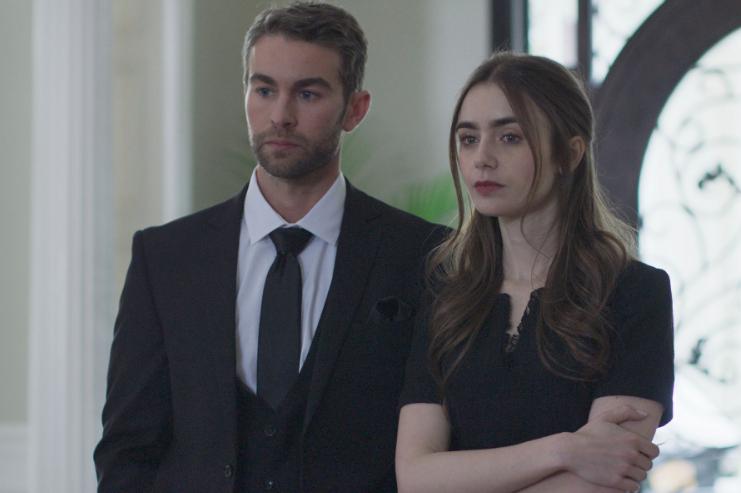
I love that. And as you just mentioned, you pick up that montage theme with the cross-cutting at least two other times in the film; one, where we’re cross-cutting between Lauren and Morgan as he’s working out and training and she’s running around and doing what she does as a lawyer, and then we have another incredible cross-cutting montage at the one hour 15 minute mark with Lauren just absolutely freaking out. They are so effective. And the way you place them within the story construct at very powerful moments, very key moments, that lead us right into another big surprise in the Monroe family. We have a lot of surprises in this film, Vaughn.
We do. I love a rug pull. I love twists and turns. I think that both as a viewer and as a filmmaker, I love following the trails and feeling shocked and surprised in the cinema. I love that feeling. And for me, editorially, there’s a lot of elements to this show that are the classic potboiler thriller and I thought if we can find a way of engaging in the sort of the emotional and psychological complexity of Lauren and what she’s going through, and if we can find a way to create and demonstrate that anxiety to the audience, I thought that would be a really good way to go. And I’m so glad to hear it really connected for you.
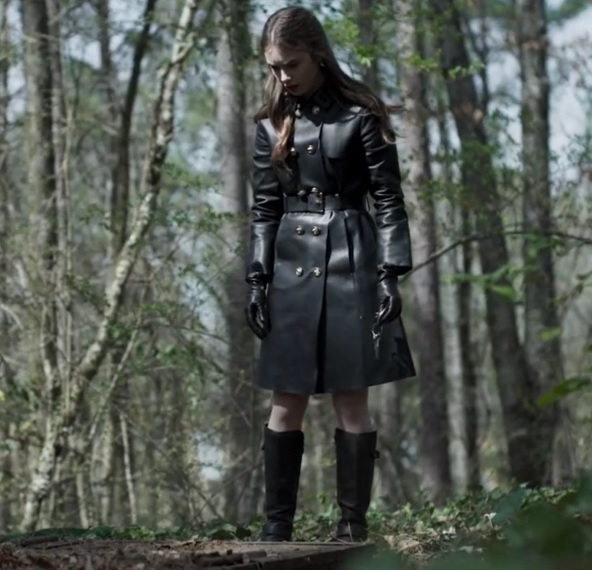
It really does. And kudos to Kristi [Shimek] and her editing because the pacing of this film is wonderful. It really keeps the suspense going through the entire film, which is very difficult to do.
Yeah. And Kristi did the most amazing, amazing job. What I think was important for us, and I know what grabbed me when I read the script, was the fact that there was this sort of top-flight, labyrinthine, high stakes, New York thriller on one hand, but also this sort of very simple, very prescient and satirized movie in there about the monster in the basement, skeletons in the closet, the dark secrets of legacy and the collection of privilege. And I think, to try and find the pace to it that kept the audience moving through, that kept them on the roller coaster ride, was really important. It’s a dark fairy tale. It’s folkloric. It should be simple and it should move at a pace. And I think she did an amazing job doing that. She’s a wonderful editor.
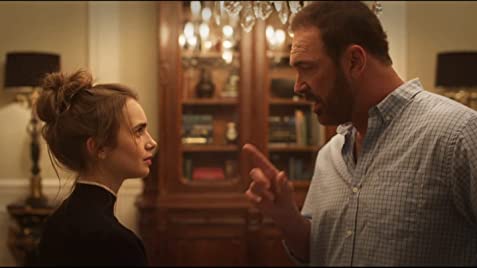
I’m very, very impressed with this – and the fact that we aren’t really given a moment to breathe, especially in the third act. We’re just along for the potboiler the whole time. Something that you do that I just absolutely love, is the surreptitious placement and use of chess pieces and a chess game. I loved seeing that. We see Archer with a chess game set up, we have Morgan with a chess game set up in the bunker and the pieces thrown about. We see Lauren and Morgan play chess. We see Morgan taking a chess piece. The whole idea of the chess game and it’s move and counter move over decades with the Monroe family is so telling. I found that so delicious that you interwove that within the visuals.
Oh, thank you! I mean, you’re spot on. I jealously watch people play chess. I am a terrible, terrible chess player, but I love, I love the idea. It’s a very understandable and intelligible metaphor for people about thinking ahead, about strategy, about the way that you move your pieces in order to facilitate the win. And both Morgan and Lauren are excellent chess players and they’re both looking to maneuver around each other. Morgan, even though, spoiler alert, he’s the one in chains, this skeletal emaciated man sitting in the bunker, but at the same time, he is able to sort of keep Lauren in his orbit with sort of chess moves of drip-feeding her information, playing different pieces as when emotionally knowing when to appear vulnerable, knowing when to be enraged, knowing how to manipulate her. I think also, just tonally, we actually tried to reflect chess in a lot of the design. The clothing choices in the latter half of the film, they go for a monochrome black and white look. When we use top shots in the film, we thought about what a chessboard looks like when you look down on it. And actually it was even in meshed in the DNA of the room. We actually chose, Diane Millett, the brilliant production designer and I, we sort of chose to draw chessboard on onto this table so that it was sort of built into the very fabric of the room. And I think that was really effective.
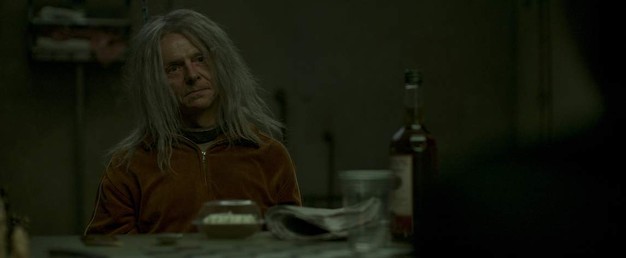
And of course the entire bunker, access to the bunker, that’s a perfect square, like a chessboard.
Exactly. Exactly right. Yeah, yeah, yeah! You’re the first person who’s picked up on that!. I’m going to tell Diane that. That’s exactly right. Sort of the idea in that top shot, and Lily [Collins] was wearing the most amazing sort of funeral outfit for that bit, when we were doing the top shot when we looked down on her, the idea was that she looked like a black queen. The silhouette and the sort of the look of her in the top shot of walking into the black square was very much visually inspired by the idea of looking down on the chessboard.

Oh, I just love that! But talk to me about the collaboration with Diane and your cinematographer, Michael Merriman. The construction and design of the bunker, in particular, is so key to the whole labyrinth idea and the maze and the gamesmanship of what’s happening, but that bunker also presents challenges for Michael as a cinematographer in terms of angles and freshening things up and not letting it get stale with just seeing a guy in chains. And then your lighting in that bunker is so fabulous for those sequences. So I’m curious about that collaboration amongst the three of you to really make that so visceral.
You are absolutely spot on. It was really important to us. Merriman and Diane and I, than within the bunker where so much of this takes place, and even though it’s claustrophobic and dank and oppressive, we wanted to make sure that there was enough uniqueness to the space that we could create beautiful frames and interesting angles. What we sort of hit upon, again to come back to this duality in the script, was this idea that we would have a camera language that was very noir-ish, quite oppressive, using a lot of shadow, using a lot of faces kind of wreathed in silhouette downstairs, and sort of lead into noir, into elements of horror down there, and let that inform the camera language. Whereas upstairs, the camera moves much more fluidly with much more Steadicam, dolly and track. We tried to create a sense of two very different feelings that the audience would get from that.
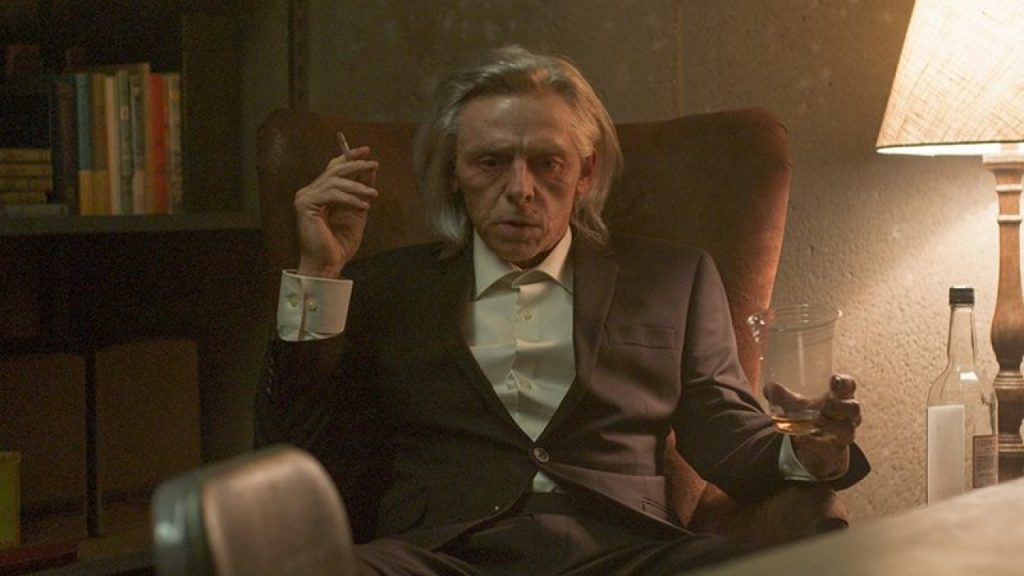
In terms of the bunker itself, it was really, really interesting because Matt Kennedy, the writer, and I discussed a lot whether we would give any legitimacy, any backstory, to the bunker. The idea that I’d had, and the way I asked Diane to think of it, conceive it, was that old man Monroe, the sort of grandfather of Lauren, he was in a Cold War era and he grew up in the sixties, was paranoid about the Cold War and the Russian threat and nuclear armageddon. And he built this bunker in his garden as a lot of Americans did actually. Some amazing and very strange things. So Diane then took that idea and we looked at some blueprints of these old fallout shelters and the idea of having this sort of weird time warp down there, the set dressing is very, very anachronistic. We’ve got kids clothes from the ’60s and bunk beds from the ’60s. We just wanted it to feel like this bizarre, lost in time, very strange, very disorientated, amputated space. I think that that also, of course, gave us what we needed for act three, the first part of our crescendo, we needed this sort of basement warren of rooms. And yeah, she did an incredible, incredible job with that. I was so delighted with that set.
The way Merriman designed and shot, we used a lot of contrasting color temperatures, kind of warm tungsten yellows, a cool metallic green top light in the actual bunker itself to sort of create differentiation. We just wanted to keep it fresh. We wanted to make sure that the audience wouldn’t get bored of watching these incredible two actors. We wanted to keep it visually interesting.

Well, you definitely succeeded there. Another element of this film, and I love what you did with it, is your score. Marlon Espino’s score. But then with your sound design, it’s almost if the score is like a constant presence, almost like Archer is speaking from the grave through the entire film. It’s very faint in some parts, but it’s there, always in the specter of Lauren’s life. So I’m curious about your discussions with Marlon in creating the score you have, and then the sound design, the mix of it, to allow for that feeling of that hauntingness, that we get.
It’s a great question. What we talked about very, very on was trying to blend two quite different things. We wanted the film to have a really strong emotional heartbeat, and I wanted to make sure that the audience experienced the loss and the pain, and the sort of disintegration of Lauren with what she’s going through. But then at the same time, I wanted to make sure that we were able to embrace the younger elements and we could lean into that thrills and chills and play on the horror beats and play on the sinister moments. I think what he did, the way that he sort of blended the lamenting piano string score with this very dark tonal, very anxious, sort of underscore that takes over at various points was astonishing. And Ben Wilkins, the sound designer, was an amazing, amazing guy as well. What we talked to a lot was being sort of in Lauren’s mind. We have to utilize the sound design to sort of experience her psychology, and creating sort of bubbles around when she’s not paying attention in court or hearing Archer’s whispers, just very generally in the mix, so when she’s experiencing these panic attacks. And also just very basic stuff like ring tones in the bunker, just giving that constant sense of sort of unease and discomfort downstairs and then really opening it up and really feeling the openness of the rooms and the birds chirping and the wind blowing through the trees. And again, a lot of it was about that duality and being able to combine ideas so that they didn’t run into each other, but they created a very intense watch for the audience.
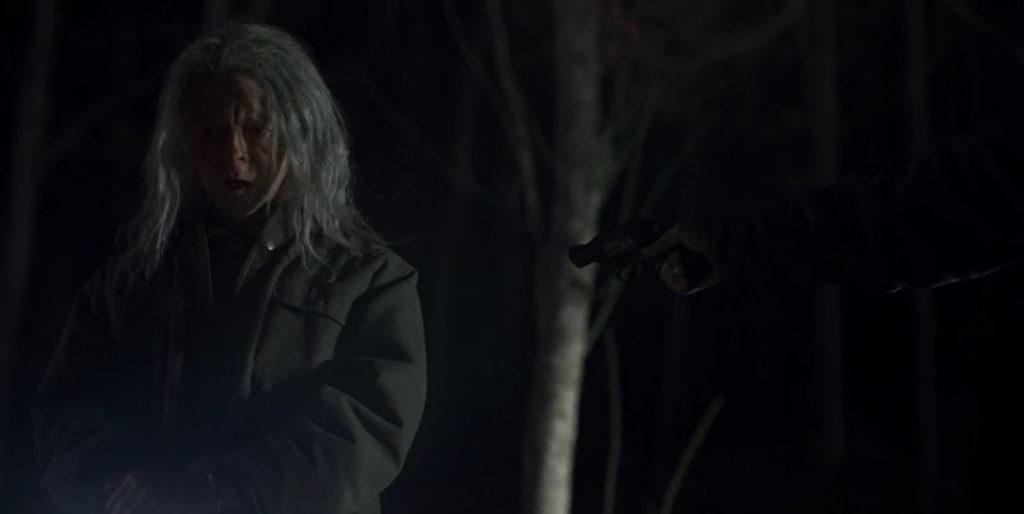
Absolutely. It’s a sensory experience on many levels here, Vaughn. One last question, so I’ve got to ask the big one – Simon Pegg. Wow! Wow! Wow! Wow! I hope in whatever awards campaigns we have in this life in the time after COVID, Simon’s name is bandied about. What made you go with Simon for the role of Morgan? We’ve never seen this from him before, Vaughn.
No. And I mean, it’s when you look at it and you think, “How hasn’t he done anything like this?” The guy’s a world-class actor. An unbelievable talent. Having worked with him on Terminal and seeing the way he embraced the darkness of that role, when I first heard of this script, I remember thinking, “I’d love to see Simon do this.” And his physical transformation, the way that he totally changed his physique for the role which he created with sort of a prison body, obsessive exercising of an inmate, someone who had nothing else to do all day, that was amazing! We also discussed characters in literature, like Hannibal Lecter and Tom Ripley, and the idea of this Machiavel, this sort of chess playing sociopath who was able to, at various points, use his emotional arsonry to manipulate Lauren. He could be vulnerable, he could be vicious, he could be violent and he could be another word beginning with “v” apparently. He was just incredible. He was like a chameleon. Yeah. I mean, it was, he’s learned, you know what? This is, it was such a pleasure to watch it and sort of news himself. It was incredible.
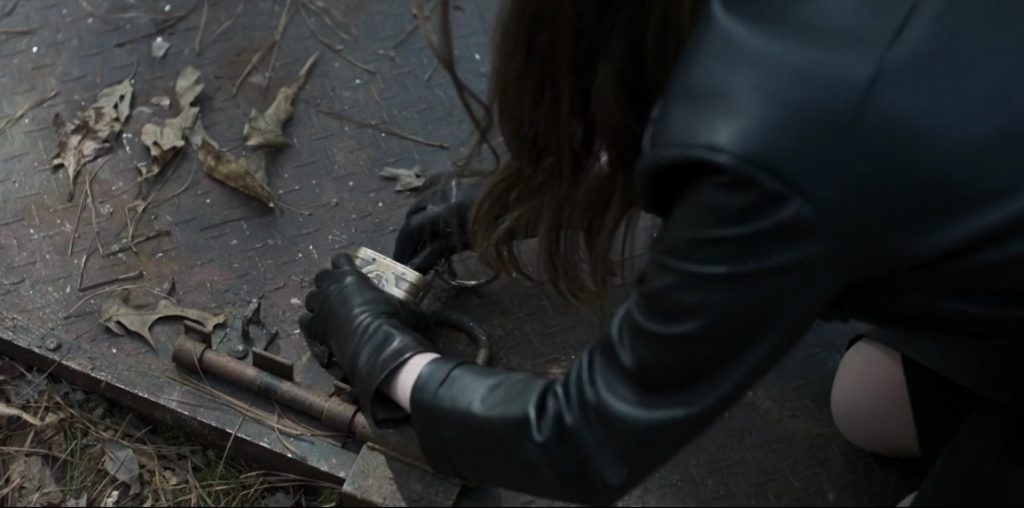
Just so well done, Vaughn, on every level. I can’t wait to see what you do next.
Oh, thank you so much. Thank you. Really that’s so kind. I’m really touched. I really appreciate it. Thank you. I will let Mother Stein know. She’ll be happy.
by debbie elias, exclusive interview 05/19/2020
INHERITANCE is available on DirecTV and On Digital and On Demand on May 22 from Vertical Entertainment.












